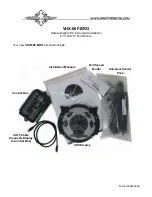
Eclipse User Manual
Release 4.0.1
Page 51 of 66
Eclipse User Manual
Utilities
Transmitting and Receiving Data via the Serial Port
The serial port can be used to transmit data between the Eclipse and a
computer or between the Eclipse and another Eclipse. It is an IBM PC
type RS232 connector, which looks like a modem to the connected com-
puter. You can set up the serial port’s parameters under
SETUP
page 2
MIDI SERIAL
.
The first parameter,
(BAUD)
, determines the speed at which messages will be sent out the serial port and
the speed at which the Eclipse expects to receive messages at the serial port. The default value,
off
, dis-
ables the serial port. The second value,
auto
, attempts to “read” the incoming data’s speed and then ad-
justs the Eclipse accordingly. Subsequent values specify specific speeds. Similarly,
(DATA BIT)
,
(STOP
BIT)
, and
(PARITY)
all describe aspects of the messages sent out the serial port and aspects of the mes-
sages that the Eclipse expects to receive at the serial port.
For things to work properly, all of these parameters must be set to the same values on both the Eclipse and
the machine connected to the serial port. Higher baud rates result in faster transmission times, but most
machines have a ceiling above which errors occur. So, set the baud rate to the highest value that you can
on both the Eclipse and the machine connected to its serial port that results in error-free transmissions.
(DATA BIT)
is normally set to
8
,
(STOP BIT)
is normally set to
1
, and
(PARITY)
is normally set to
None
.
You should only need to stray from these values if the device the Eclipse is communicating with is con-
strained to some other values. If that is the case, change the values on the Eclipse to match the other de-
vice.
To aid in troubleshooting, the
BUSY
LED will flash when data is transferred at the serial port, provided no memory card is in
place. If the serial port is “enabled,” messages sent out the MIDI Out port are also sent out the serial port. Note: If both the
serial port is “enabled” and MIDI is “enabled,” a command received over either the serial port or the MIDI In port causes the
port not receiving the command to be ignored until the command is complete.
The pin-out for the serial port is:
1 DCD
2 RXD
6 DSR
3 TXD
7 RTS
4 DTR
8 CTS
5 gnd
9 nc
For most applications, only pins 2,3, and 5 need be connected.
Dumping Data Via the MIDI and Serial Ports
You can “dump” data from the Eclipse for external storage or for use in another Eclipse. The dumped data
will be system exclusive and will be sent out the MIDI Out port and the serial port. None of the MIDI pa-
rameters at
SETUP
page 2
MIDI
has any bearing on dumps except for
Device ID
. The Device ID is used
as part of the system exclusive messages in the dump. While the dump is occurring, a running display of
the number of bytes sent is presented for those keeping score at home. You can reload the dumped infor-
Summary of Contents for Eclipse
Page 2: ...This page is intentionally left blank ...
Page 64: ......
















































